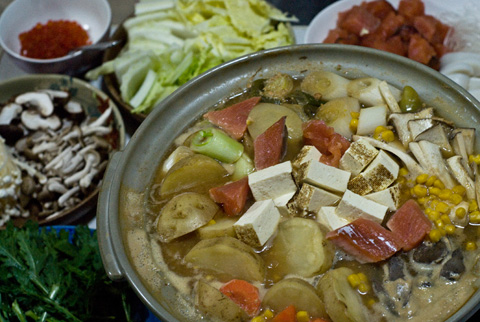If you live outside Japan, you might be tempted to believe (due to the selection that’s available at most stores) that miso comes in two varieties: white and red. Well think that no more. Miso, a fermented paste of soy beans, salt, and koji (a special kind of mold that is usually used by inoculating rice or barley), is a delicious and many-flavored thing. There are so many different varieties that vary by regional tastes and traditions. Basically, Kyushu is home to mugi miso made with barley, different varieties of kome miso made with rice are found across Honshu, and Nagoya is the birthplace of the slightly funky-tasting all-soybean Hatcho miso. In addition to color (varying shades of brown, but usually described as white or red) miso can be classified by it’s texture, level of sweetness to saltiness, and flavorfulness. Many misos are associated with the region they originated in: Saikyo (Kyoto), Echigo (Niigata), Edo-mae (Tokyo), Akita, Shinshu (Nagano), Sendai, and the list continues. Most families keep at least two types to mix their own special blend, called awase miso.
A glowing review in the Japan Times led me to Sano Miso in Tokyo’s Kameido neighborhood. I love seeing their rows of miso barrels with their conical lids, ready to be lifted for a whiff of the miso’s fragrance. The sales staff helpfully made recommendations and would mix up quick cups of miso soup so that I could taste and compare the flavors. There are so many varieties, so it’s really necessary to taste a few before you make your decision. In addition to miso, the store stocks other pantry necessities like dried kombu, katsuo flakes, soy sauces, vinegars, and so on. I highly recommend the giant, delicious, and not too sour umeboshi and the jidai mame, peanuts with a sweet, crunchy coating.
At first, I would stop in when I was in Tokyo on other business, but the train ride out to Kameido and back wasn’t exactly quick. On my last visit, I asked if I could get my miso by mail order. What luck, they gave me their catalog and their web address. Not only can I have my miso delivered right to my door, but with shipping all over Honshu just 290 yen, mail order costs less than a round trip on the train. How wonderful!
After poring over the descriptions of each miso (and finishing the miso that I still had from my previous visit to the Kameido store), I prepared my order. I settled on 500 grams each of red Kogane miso, white Kogane miso, Nagasaki mugi miso, and Sendai miso, along with a case of amazake and a few bags of jidai mame. My order arrived just a few days later with a bill to be paid at the convenience store. And the miso? Fantastic–my favorites are the red Kogane miso and Nagasaki mugi miso, both of which are sweet and flavorful. (I have been very happy with all of the miso that I’ve bought from Sano Miso, with the one exception being their Saikyo miso, which seemed too mild and a bit floury tasting.)

500 grams each (left to right) of white Kogane miso, Nagasaki mugi miso, red Kogane miso, and Sendai miso.
I store my miso in 450 mL glass storage jars from Muji (the stackable rectangular shape fits in the refrigerator more efficiently). I was surprised that I could fit 500 grams of miso in a 450 mL container (with room to spare) until I realized that the salt used to produce the miso makes it somewhat more dense than water. Not surprisingly, the saltiest of the four, Sendai miso, takes up the least space.
If you’re interested in ordering some miso for yourself (in Japan of course), start from Sano Miso’s website. Even if you’re Japanese isn’t quite up to snuff, you can do it easily with some help from Google Translate.








